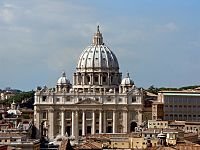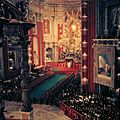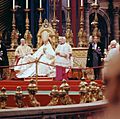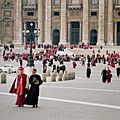Second Vatican Council facts for kids
Quick facts for kids Second Vatican Ecumenical CouncilConcilium Oecumenicum Vaticanum Secundum (Latin) |
|
|---|---|

Saint Peter's Basilica
Venue of the Second Vatican Council |
|
| Date | 11 October 1962 – 8 December 1965 |
| Accepted by | Catholic Church |
|
Previous council
|
First Vatican Council (1869-1870) |
| Convoked by | Pope John XXIII |
| President | Pope John XXIII Pope Paul VI |
| Attendance | up to 2,625 |
| Topics | The Church in itself, its sole salvific role as the one, true and complete Christian faith, also in relation to ecumenism among other religions, in relation to the modern world, renewal of consecrated life, liturgical disciplines, etc. |
|
Documents and statements
|
Four constitutions:
Three declarations:
Nine decrees:
|
| Chronological list of ecumenical councils | |
The Second Ecumenical Council of the Vatican, or Vatican II, was the twenty-first Ecumenical Council of the Roman Catholic Church. Pope John XXIII started it in 1962. It lasted until 1965, when Pope Paul VI ended it. Four future popes took part in the council's opening session: Cardinal Giovanni Battista Montini, who on succeeding Pope John XXIII took the name of Paul VI; Bishop Albino Luciani, the future Pope John Paul I; Bishop Karol Wojtyła, who became Pope John Paul II. Father Joseph Ratzinger, who was only 35 at the time, was there as a theological consultant. More than forty years later, he became Pope Benedict XVI.
Different things were discussed. These aimed at modernising the church, and opening a dialogue with other religions. Many people see these meetings as the most important event in the Catholic Church in the 20th century. They let Mass be in different languages.
Images for kids
-
A Catholic priest celebrating Tridentine Mass, the form of the Mass prevalent before the council, showing the chalice after the consecration.
-
Paul VI presiding over the introductory ingress of the council, flanked by Cardinal Alfredo Ottaviani (left), Cardinal Camerlengo Benedetto Aloisi Masella and Monsignor Enrico Dante (future Cardinal), Papal Master of Ceremonies (right), and two Papal gentlemen.
-
The abolition of Friday of Sorrows of the Virgin Mary is an example of changes in the Liturgical Calendar after the council. The Virgin of Hope of Macarena, Spain.
See also
 In Spanish: Concilio Vaticano II para niños
In Spanish: Concilio Vaticano II para niños











